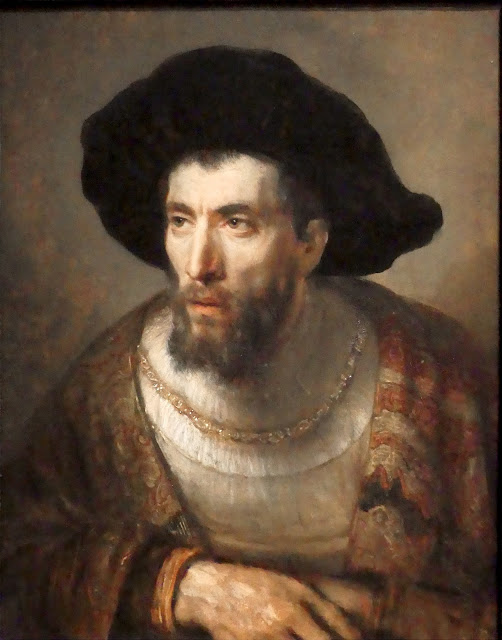
This c. 1653 painting entitled The Philosopher from the workshop of Rembrandt hangs in the National Gallery of Art in Washington, DC.
With piercing, deep-set eyes, this bearded man leans forward and stares off to his right. He wears a wide, floppy beret and a red-and-yellow patterned robe draped over his shoulders. While this mysterious and intense figure has traditionally been identified as “The Jewish Philosopher,” this designation is undoubtedly fanciful. Nevertheless, the image clearly depicts a concerned individual who seems to be actively brooding over his thoughts.From 1639 until 1656 Rembrandt lived in a large house on the Jodenbreestraat on the edge of the Jewish quarter in Amsterdam. During those years, and particularly from the late 1640s, he frequently depicted Jewish models in his paintings. As Rosenberg has suggested, Rembrandt probably found in the picturesque faces of the Ashkenazi Jews an intense spirituality that suggested to him the spirit of the people who populated the ancient world. At a time when he was searching for a deeper emotional understanding of biblical and historical figures, he found in these care-worn faces an underlying philosophical awareness of human existence. Although a painting such as this was undoubtedly executed from life, it was not considered a portrait in the conventional sense, but rather a tronie, a bust-length figure study that was an imaginative evocation of the model. -- NGA
Although the painter of this work is unknown, it is generally acknowledged that it was not Rembrandt van Rijn.
A close examination of the painting techniques in The Philosopher indicates that this work, though executed with great sensitivity, cannot be by the master. A number of stylistic similarities exist between this work and paintings by one of Rembrandt’s pupils, Willem Drost. Many of Drost's male sitters, for example, stare intently out of the picture plane, as does this man. The Philosopher is painted on a panel made out of two different types of wood. Most of the image is on a walnut panel, whereas the hands are painted on an oak strip joined to the walnut along the bottom. The hands must have bothered an early collector or restorer because, from the time this painting first entered the Rembrandt literature until it was cleaned in 1981, they were covered by overpaint. -- NGA

No comments:
Post a Comment